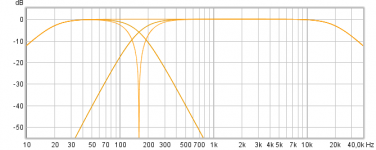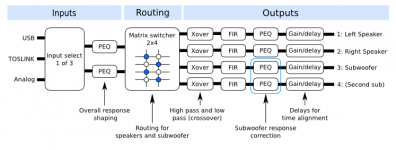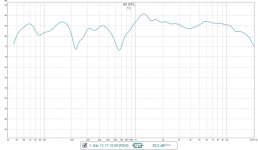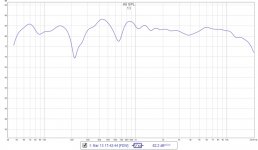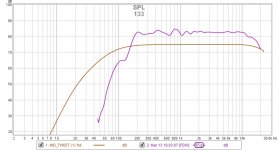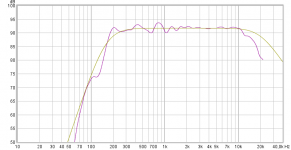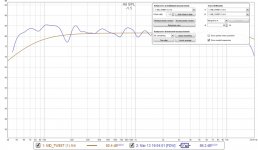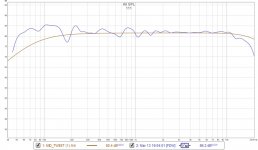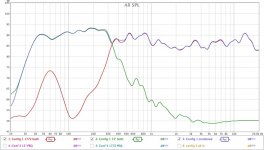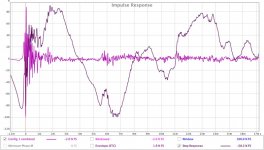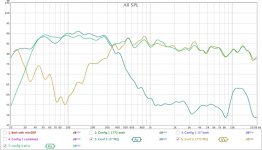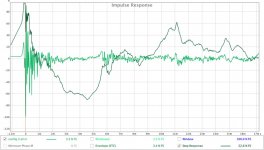Hi mkane77g sorry I'm late, find attached the two target slopes for 4th order LR at 160Hz, those shall help us with slope and balance the two band pass levels flat relative to each other and when one have its polarity reversed we shall find the deepest null to get them timed in sync at design axis.
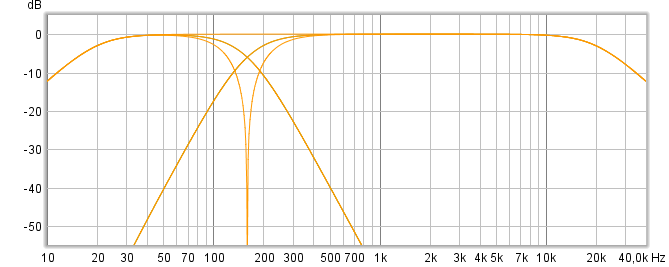
A couple of notes is please don't move microphone position between sessions unless you have measures so it can be brought back to exactly same position and my guess is have it 1 meter or bit more from baffle to have a chance woofer dispersion get prober within measurement, other thing is don't change any cables or chain devices in session or down the road because they inside system calibration, and also please ensure polarity is normal for woofer and mid-tweet so they both fire forward on positive pulse because both LR4 and Harsch slopes need this, in principle it doesn't matter if one device in chain output in reverse by design or a speaker cable is reversed somewhere by mistake or at will, your tool to quality check polarity is look in REW for the same session where individual measurements per woofer and per mid-tweet then under "Impulse" graph shall show impulse and step response have positive upward direction and if not correct it/them by either reverse speaker cable or tick reverse polarity for that particular channel somewhere inside miniDSP unit.
Had a look over miniDSP site for your unit it looks PEQ in "Inputs" section you can use later to dial a house curve and for Harsch session we will use "Outputs" section to dial in pass bands using "Xover" "PEQ" "Gain/Delay" dialogs, in principle "FIR" dialog could be used to linear excess phase developed by LR4 XO point but in its limited to 1024 taps its not practical and precise enough down at a 160Hz number, advise is keep an eye for gain structure settings somewhere in the various dialogs, setting a -6dB or more would be normal to stay free of nasty clipping.
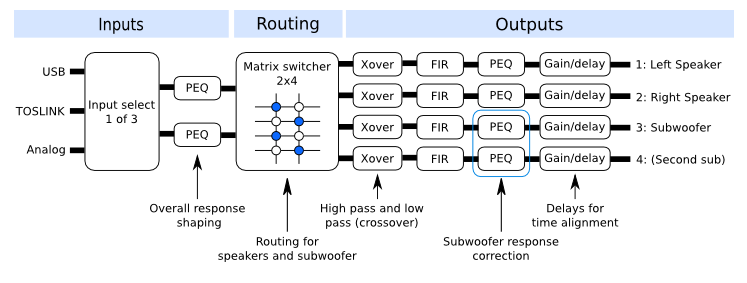
Lets start look at get mid-tweeter pass band dialed in, you have free hands use whatever electric PEQ or Xover slopes in miniDSP to get mid-tweeter response massaged to perform a relative smooth flat acosutic HP LR4 @160Hz slope seen from microphone, except for one filter than you have to set which is a electric HP BW2 @160Hz. This is because in that LR4 is the same as two cascaded BW2 filters then down the road if we disable that electric BW2 filter in miniDSP we will end a BW2 acoustic slope which is easy transfer to BS2 we need for Harsch setup. That said i made some simulation based on manufactures response times your current baffle and suggest as a first thing set those filters below for mid-tweeter and sweep it verse the BS2 @160Hz target to see if it get as close as predicted in below simulation, if it does set one more HP BW2 @160Hz plus two PEQs 160Hz/Q0,58/-1,3dB and 160Hz/Q0,7/-0,5dB and you should have a LR4 slope.
Set these corrections:
High pass filter BW2 (Q0,7071) @160Hz
PEQ 340Hz/Q2/-2,64dB
PEQ 420Hz/Q1/-4dB
PEQ 950Hz/Q5/+3dB
Shelving high 15kHz/Q2/+6dB
Shelving high 8160Hz/Q2/-2,4dB
Shelving low 145Hz/Q1/+3dB
Above 6x corrections:

Predicted simulation of above 6x corrections verse a BS2 target curve:

Will keep eye to new posts but soon its night here so will drift a bit off line.
A couple of notes is please don't move microphone position between sessions unless you have measures so it can be brought back to exactly same position and my guess is have it 1 meter or bit more from baffle to have a chance woofer dispersion get prober within measurement, other thing is don't change any cables or chain devices in session or down the road because they inside system calibration, and also please ensure polarity is normal for woofer and mid-tweet so they both fire forward on positive pulse because both LR4 and Harsch slopes need this, in principle it doesn't matter if one device in chain output in reverse by design or a speaker cable is reversed somewhere by mistake or at will, your tool to quality check polarity is look in REW for the same session where individual measurements per woofer and per mid-tweet then under "Impulse" graph shall show impulse and step response have positive upward direction and if not correct it/them by either reverse speaker cable or tick reverse polarity for that particular channel somewhere inside miniDSP unit.
Had a look over miniDSP site for your unit it looks PEQ in "Inputs" section you can use later to dial a house curve and for Harsch session we will use "Outputs" section to dial in pass bands using "Xover" "PEQ" "Gain/Delay" dialogs, in principle "FIR" dialog could be used to linear excess phase developed by LR4 XO point but in its limited to 1024 taps its not practical and precise enough down at a 160Hz number, advise is keep an eye for gain structure settings somewhere in the various dialogs, setting a -6dB or more would be normal to stay free of nasty clipping.
Lets start look at get mid-tweeter pass band dialed in, you have free hands use whatever electric PEQ or Xover slopes in miniDSP to get mid-tweeter response massaged to perform a relative smooth flat acosutic HP LR4 @160Hz slope seen from microphone, except for one filter than you have to set which is a electric HP BW2 @160Hz. This is because in that LR4 is the same as two cascaded BW2 filters then down the road if we disable that electric BW2 filter in miniDSP we will end a BW2 acoustic slope which is easy transfer to BS2 we need for Harsch setup. That said i made some simulation based on manufactures response times your current baffle and suggest as a first thing set those filters below for mid-tweeter and sweep it verse the BS2 @160Hz target to see if it get as close as predicted in below simulation, if it does set one more HP BW2 @160Hz plus two PEQs 160Hz/Q0,58/-1,3dB and 160Hz/Q0,7/-0,5dB and you should have a LR4 slope.
Set these corrections:
High pass filter BW2 (Q0,7071) @160Hz
PEQ 340Hz/Q2/-2,64dB
PEQ 420Hz/Q1/-4dB
PEQ 950Hz/Q5/+3dB
Shelving high 15kHz/Q2/+6dB
Shelving high 8160Hz/Q2/-2,4dB
Shelving low 145Hz/Q1/+3dB
Above 6x corrections:
Predicted simulation of above 6x corrections verse a BS2 target curve:
Will keep eye to new posts but soon its night here so will drift a bit off line.
Attachments
Last edited:
Do I need to set the xover both @ 160?
It all depends if my predictions works and you get a satisfying curve close to the earlyer released BS2 @160Hz taget curve then either cascade another BW2 @160Hz and if miniDSP can't cascade two filters in a row then edit the first BW2 @160hz to be a LR4 @160Hz and still add the other two PEQ. But if above doesn't come close to BS2 @160Hz target curve then do whatever you want to come close to the latest LR4 @160Hz target curve, but there shall be used one HP BW2 @160Hz filter to get there else later i can't transfer it back in a easy way from LR4 to BS2 both @160Hz : )
EDIT to use those target curves import them into session and to overlay measurments to target curves use either "All SPL" tab or "Overlays" graph window and to move those target curve up and down wards in SPL relative to measurements use "Controls" dialog when target curvet is highlighted out at most left side of REW.
Last edited:
Am I ready for the next procedure?
Don't know : ) have you hit either a HP BS2 or LR4 @160Hz smooth response for mid-tweeter you can share overlaid with target and Y axis set to cover a no more than 50-70dB scale, for reference here is how Rokytheman presented his two pass bands overlaid with target curves back in post 386.
Cant get the woofer textbook to show. How do I manipulate the measurement? manually or with the auto feature. The auto feature seems limited. actually, I'm the one limited.
Target curve you show there is the outdated 80Hz BS2 where my post 441 have the two LR4 targets up at 160Hz we target for now and down the road when we transfer back to Harsh then post 418 have those LP BW4 / HP BS2 @160Hz attached.
Have traced your not bad latest mid tweeter curve and overlaid to target curve, tips import the right target curve and for REW to remember changes when opening session next time, go "File" "Save all measurements" "enter a note in dialog" and point to same name that was the opening up file or give it a new name if its a new session. To manipulate target file up or downwards in SPL use the "Controls" in upper right corner and look for "Offset" and once again if you want changes to be remembered go "File" "Save all measurements" etc...
Attachments
Last edited:
I'm not shure too but many times seen its practice to offset exactly relative to 1kHz point and there you only 0,1 or 0,2 dB far but for curves with ripple as here guess a average in middle of those ripples is fine so you probably there by now for the one you show there that use the old 80Hz target file.
EDIT Great its also middle in the night here, Bon appetite see you tomorrow.
EDIT Great its also middle in the night here, Bon appetite see you tomorrow.
Last edited:
Good night Byrtt! 
All this talk made me re-visit my setup.
Talking with Byrtt a while back, he mentioned to me as well, not to use the XO in the miniDSP but "forge" the curves with PEQ.
I had tried a couple of times previously, but could never do something I like and that looked like a XO curve! So, I would just revert to the XO in the miniDSP and said to myself: "Next time!"
Well, today was the day, I thought.
I sat down in front of the computer, mic at listening position (oops, now I realize... should I have done my measurements at 1m off the baffle?), and go!
Took me 2 hours, but it came out better than all my previous attempts.
Sound improved as well. Cleaner, clearer and funny thing, the 1772 didn't so much adjustments this time around.
I have huge glitches with my sound card. It pops internally, so, the big peaks at 60Hz, and in the high end of the 1772 are glitches. I was able to run a couple of cleaner sweeps, without pops.
I like the improvements. Sound is more detailed, I hear more things.
Config1 is with the miniDSP XO (Harsch) and Config2 is my attempt at following the curves of the Harsch XO with PEQ only. There is a slight added PEQ on the combined curve to take out some peaks and flatten the FR.
All this talk made me re-visit my setup.
Talking with Byrtt a while back, he mentioned to me as well, not to use the XO in the miniDSP but "forge" the curves with PEQ.
I had tried a couple of times previously, but could never do something I like and that looked like a XO curve! So, I would just revert to the XO in the miniDSP and said to myself: "Next time!"
Well, today was the day, I thought.
I sat down in front of the computer, mic at listening position (oops, now I realize... should I have done my measurements at 1m off the baffle?), and go!
Took me 2 hours, but it came out better than all my previous attempts.
Sound improved as well. Cleaner, clearer and funny thing, the 1772 didn't so much adjustments this time around.
I have huge glitches with my sound card. It pops internally, so, the big peaks at 60Hz, and in the high end of the 1772 are glitches. I was able to run a couple of cleaner sweeps, without pops.
I like the improvements. Sound is more detailed, I hear more things.
Config1 is with the miniDSP XO (Harsch) and Config2 is my attempt at following the curves of the Harsch XO with PEQ only. There is a slight added PEQ on the combined curve to take out some peaks and flatten the FR.
Attachments
perceval, you shold play with delays more. Try to add more delay to highpassed section (mains) and then look at summed output and step response form.
I got huge improvement in sub/lowbass integration after setting LR2 slopes instead of LR4. It improves timing/phase and I feel that bass is unbelievably tighter and punchier. My xos were 80-160Hz I tried tens of arrangements!
I got huge improvement in sub/lowbass integration after setting LR2 slopes instead of LR4. It improves timing/phase and I feel that bass is unbelievably tighter and punchier. My xos were 80-160Hz I tried tens of arrangements!
I haven't tried brutal LR8. I'll stick to try making the Harsch workout well, then move to something else to compare.
Juhazi, I have 1.65ms delay on the 1771, which at 300Hz XO point is half the period, as it is prescribed with the Harsch XO. I could try to change the delay to find how it will affect the response.
Juhazi, I have 1.65ms delay on the 1771, which at 300Hz XO point is half the period, as it is prescribed with the Harsch XO. I could try to change the delay to find how it will affect the response.
@Perceval, if this second graph:
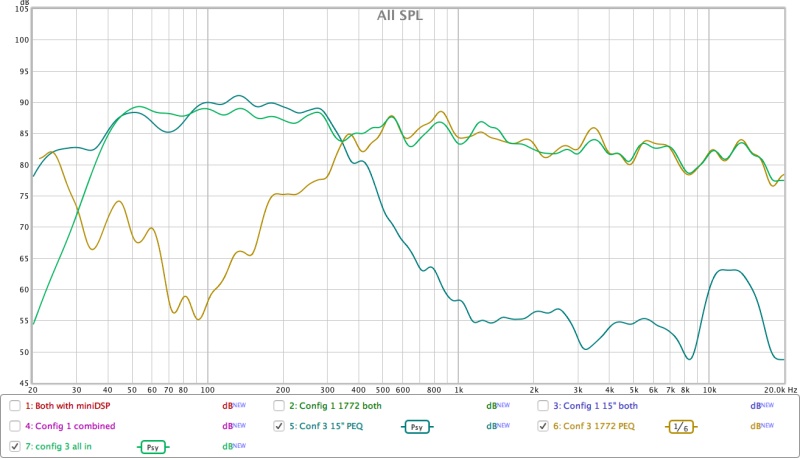
is done by PEQ only, you should set a highpass filter at 100 Hz on the tweeter and a lowpass at 800 Hz on the woofer. It won't influence the curves as the SLP is down already but it will prevent the tweeter (well a big one ) to do low end and the woofer to have to sing the high notes. It might be easier to take the first setting and use PEQ to get them aligned with the targets. Just prevent them to climb back up as they will be out of phase there.
) to do low end and the woofer to have to sing the high notes. It might be easier to take the first setting and use PEQ to get them aligned with the targets. Just prevent them to climb back up as they will be out of phase there.
After that you can play with the timing of the tweeter to get the right summing at the crossover. I'd use 6 cycle FDW filters, not psy for this...
is done by PEQ only, you should set a highpass filter at 100 Hz on the tweeter and a lowpass at 800 Hz on the woofer. It won't influence the curves as the SLP is down already but it will prevent the tweeter (well a big one
After that you can play with the timing of the tweeter to get the right summing at the crossover. I'd use 6 cycle FDW filters, not psy for this...
- Home
- Loudspeakers
- Multi-Way
- S. Harsch XO
